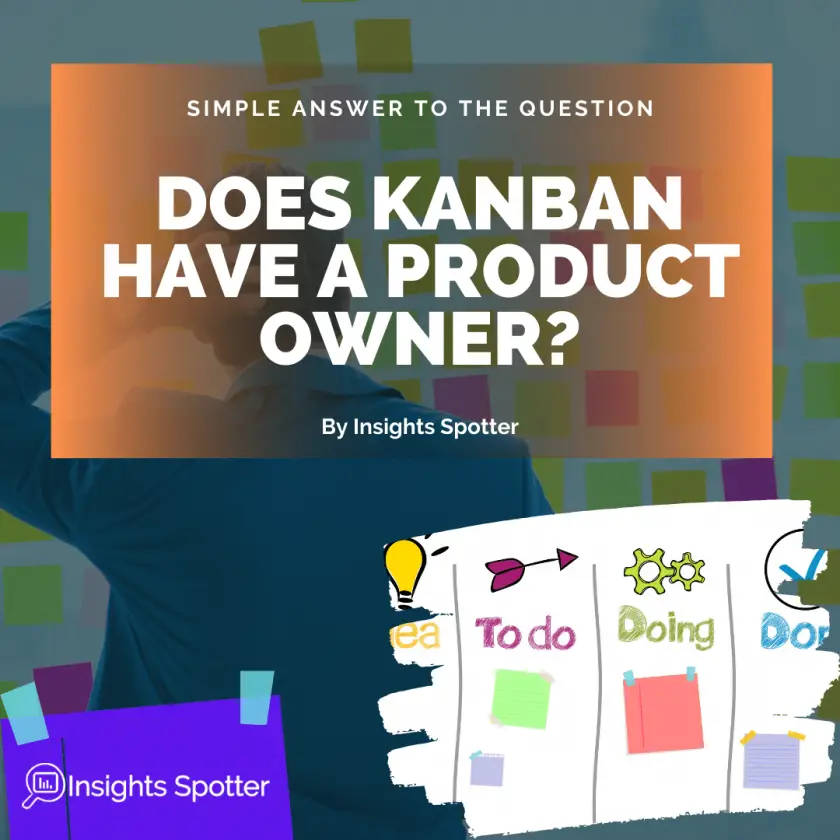Does Kanban have a Product Owner? Simple Answer
Agile, Agile, Agile, loads of people preaching about the excellent benefits, but there is much less talk about how to implement it from my experience. Nobody would blame you if you were planning to create new roles like Scrum’s Product Owner when implementing a new work management framework like Kanban.
In theory, Kanban does not have a Product Owner role. It has no prescribed roles because one of the framework’s principals is to accommodate any business process. Still, you can create one if your specific situation requires it. You might want to call it differently, Service Request Manager.
Two frameworks Kanban and Scrum, compete and collaborate to support Agile methodology implementation. Roles are somewhat similar and will have slightly different names depending on the framework you chose. So, let’s explore potential situations where the Kanban framework might benefit from a Product Owner role by understanding the role and how it helps the framework.
Btw, there are two available “hats”, Service Request Manager and Service Delivery Manager, that the team can assume when needed in Kanban. Out of the two, the service request manager would be the one to take the Product Owner role in Kanban.

Why Scrum has a Product Owner role, and Kanban doesn’t?
It all comes down to the methods and tools each framework is using. They are both uniquely adjusted to slightly different types of projects and requirements.
Scrum works well with teams that have relatively steady priorities that do not change that often over time. For example, when creating one type of product. Maybe a new search engine. I heard Apple might be doing one.
True, priorities and adjustments will change over the project’s time, but the ultimate goals will be to achieve a new search engine. Conveniently, people who look after features and backlog happened to be called “Product Owner” in Scrum.
On the other hand, Kanban is more suited to initiatives or processes with widely-varying priorities. For example, the IT service desk, IT Operations or other support work may get countless requests from multiple stakeholders, which conveniently happen to be all different issues. Now, in this situation, calling somebody a product owner is just confusing. This is where the Service Request Manager “hat” may come in.
We would usually hope to have a smaller backlog in Kanban as things should be done quickly, and detailed backlog analysis might not be continuously required. However, there are different situations in life, and we will examine this up in other sections.

Scrum’s Product Owner vs Kanban’s Service Request Manager
Who Is Scrum’s Product Owner?
The primary responsibility of a Product Owner is to manage product backlog items. In other words, he/she would order/sort items to achieve goals and mission. As a result of sorting the backlog and prioritising items to work on, the Product Owner works to optimise the development team’s value.
The Product Owner works as part of a larger Scrum team, and he/she is responsible for making sure that the team has easy access to the backlog. When it comes to Sprint planning meetings, the Product Owner will highlight items that the team need to tackle next. Plus, if the team needs more information on the work items, the product owner should provide it.
Who Is Kanban’s Service Request Manager?
Individuals who assume the Service Request Manager role are responsible for the client’s needs and expectations. The person would order work items from the backlog and work with the team to select the next work item to start.
Well, it sounds a lot like a product owner, right? The difference comes to the way the role is fulfilled. As we have mentioned before, Kanban does not prescribe roles. Typically, you start with what you have now. Still, you would need somebody talking with clients and collating the backlog requirements. Person’s role title might not even say Service Request Manager. It could be Business Analyst, Product Manager, Technical Lead or even Designer. The point is that he/she is responsible for similar tasks, and, therefore, they could all assume the role in Kanban.
Actually, if you are moving from Scrum to Kanban, you may already have a Product Owner role, and it is okay! Keep it and see what your project needs are with time.

Do you need a dedicated Product Owner or Service Request Manager role In Kanban?
When you look around or logically consider where Scrum or Kanban could be applied, you will likely conclude that a more mature team would usually be using Kanban.
Scrum, as we discussed, suited to create new innovative products or services. However, there are many medium and large companies employing a lot of people who are using legacy processes and roles. In such businesses, it would be tough to use Scrum. But if you come around and say that nothing will change, but just the prioritisation process, then you might get less pushback, and you can start looking into implementing Agile methodologies.
Now, if you are a large corporation and looking to change the way you work. It is probably because the current practice of working is not great. Well, if it was not suitable for a while, you may end up having a large backlog or competing priorities and long deliverables with people doing everything and nothing at the same time. Thus, managing a backlog becomes a priority to remove bottlenecks and improve workflow and deliverables.
If you are in such a company with similar issues, a Product Master role or Service Request Manager “hat” for a team member might just be what you need to bring a backlog under control.
If you are a small team with no large backlog, you can start using Kanban, but you do not need a dedicated person. Just do some simple teamwork and allocation, and it will work perfectly. If you spend any more time than that, you will be just stealing time from the work you can progress.

Why would you want a Product Owner or Service Request Manager in Kanban?
Sure, you get the benefits we have discussed before, like managing backlog and allocating work. But why does it matter in Kanban?
Kanban is looking to improve workflow and make sure that work items move most efficiently from start to finish. There are no bottlenecks, and work is not piling up. The whole team together tries to sort our issues and unplug flow. To achieve such goals, Kanban introduces two widely used metrics: lead time and cycle time and try to make things visuall.
What Are Lead time & Cycle Time?
Lead time measure how long it takes for the work item to move from the requirement to complete. Thus, representing a measure that indicates when a customer thinks and sees that the work is done.
Cycle time is very similar, but it starts when we add items to the backlog. Thus, representing how quickly work progress within the team.
Now, the quicker work items move through a Kanban board (If you like to learn more, check out my previous post, CAN KANBAN HAVE SPRINTS? SIMPLE ANSWER), the faster customer gets value, or the team can start work on the next item. Also, allowing to bring loads of benefits to the group and organisation, like reducing stress, showing new features, attracting more clients, enabling a business to continue operations.
Well, a Product Owner or Service Request Manager is the role that primarily is responsible for reducing both cycle time and lead time.
These individuals could help identify work items stuck in the backlog for an extended period, increasing lead time. If items are being recognised, they can be prioritised. If they are still relevant team can complete them; if they no longer bring value, they can be removed.
The PO or SRM could take one step further. They can review timings and get the most valuable items to the top of the pile through reordering and sorting backlog. Thus, unlocking value faster. In such cases, it does not necessarily reduce lead time for the whole work, but at least for items with the most value, which is arguably more important.
Finally, PO or SRM could move things forward. When the work item is in progress or close to completion, a customer might need to provide final approval or additional input. Often customers might be very busy, and work items are staying not completed. The individual could work together with the customer and find ways to get approval or input faster. Thus, reducing cycle time.

Why Is Visibility Important In Kanban?
Kanban is aiming to be a visual framework. It means that the team can either see work items literally on the actual board or in a JIRA tool. Allowing the team to see items has excellent benefits like making them part of the decision process, allowing them to see what is coming up next.
However, there are some drawbacks that PO or SRM could resolve. Having too many items on the board may confuse the whole team. The most important items might not be so visible even if clear priority was allocated.
PO or SRM may remove all work items that do not need attention in the next working period and maintain a large private backlog. Thus, reducing noise, allowing the team to concentrate on the tasks at hand, reduce stresses on a new work intake.
Therefore, introducing a Product Owner or Service Request Manager role could have enormous benefits for the team, customer and organisation as a whole.
Product Owner In Kanban Conclusion
True, Kanban does not have prescribed the Product Owner role. Yet, items need to move through the backlog to completion. If there is a small team, there are no issues and work naturally gets shared.
However, if you have a larger team or a more considerable backlog, you will need someone responsible for requirements or work items and their allocation.
Kanban is flexible enough to allow you to have any role you need and even suggests an alternative to a Product Owner role by the name Service Request Manager. SRM “hat” can be introduced to manage a backlog and look after workflow items progress. It could be a dedicated role or assumed temporarily by a team member.
As we discussed in the post, having one can have significant benefits, and even if you run a Kanban project, you should consider a Product Owner or Service Request Manager for your project or process.
Subscribe to our newsletter!
 ABOUT ME
ABOUT ME
I am an experienced ex. Business & Data Analyst and now a Project Manager with multiple years of experience gained in several international companies.
These days, business problems require data crunching and telling stories to make the right decisions. Simply put, business stakeholders need insights into their projects and deliveries.
This is where I come in. I have learned and applied Python, Power BI, SQL and Excel to analyse and present data. Also, I gained experience in Project Management and Business Analysis. So, I can not only spot insights but execute business decisions. Moreover, I can teach you as well. Read More
Best Books








Latest Blog Posts
- Navigating Project Management in a Matrix Organization: Challenges and Solutions
- Using Artificial Intelligence’s Power in Agile Project Management
- Sustainable Project Management: Trends, Tools, & Strategies
- Unlocking Strategic Value: How NIST CSF 2.0 Shapes Project Choices for Better Outcomes
- Cybersecurity Project Management: Protecting Your Digital Frontier
- What are the Different Types of Planning in Project Management?

Need Project Manager’s Help!?
Check out the Fiverr marketplace if you do not have time to run your own projects or just need extra help. They do have multiple project professionals, including project managers. Maybe you will find just the right fit to take some burden from you. I have used Fiverr in the past. The prices are also not too bad. If you seek PM via the corporate route, it will be easily 5x the price.

